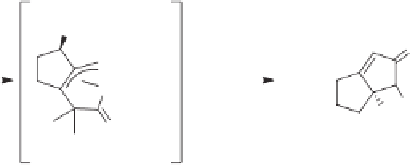Chemistry Reference
In-Depth Information
In spite of all the efforts expended in the quest for new non-metallic methodologies
for the synthesis of cyclopentenones, transition metal-mediated strategies remain the most
common approach. Apart from the Pauson-Khand reaction and related transformations,
numerous other approaches have also emerged through the years. These approaches are
discussed in this chapter.
10.2
[4
+
1] Strategies for the Synthesis of Cyclopentenones
The synthesis of cyclopentenones via [4
1] strategies can be achieved by means of various
methodologies. The use of 1,3-butadienes represents one such example. Iron tricarbonyl
1,3-diene complexes can react with aluminum halides, resulting in decomplexation of the
iron complex, to afford the corresponding cyclopentenones in good to excellent yields.
15
These reactions are normally carried out at atmospheric pressure and at room temperature
and are complete in short reaction times (usually in minutes). In 1992, Frank-Neumann
and co-workers reported a nice example of this reaction.
16
They used tricarbonyl iron
complexes of 1,1,3 and 1,1,2,3-substituted 1,3-dienes that were decomplexed under mild
conditions by aluminum halides to furnish the corresponding conjugated cyclopentenones.
Depending on the substitution pattern, spirocyclic and/or cyclocondensed cyclopentenones
can be obtained. One important feature of the reaction is its stereospecificity, which allows
the building of optically active compounds from complexes with optically active ligands.
For example, the chiral diquinane
18
has been synthesized from the chiral diene
16
.The
corresponding cycloadduct was obtained as a 9:1 mixture of diastereomers, indicating that
the cyclocarbonylation is a stereoselective process (Scheme 10.6). This study revealed that
the reaction proceeds via an acyl
+
-allyl complex, whose formation is promoted by the
coordination of aluminum bromide with a carbon monoxide ligand.
Me
Me
O
Fe(CO)
9
AlBr
3
,CO
Me
Me
Fe(CO)
2
Me
H
18
Me
O
AlBr
3
Me
9:1 d.r.
16
17
Scheme 10.6
Synthesis of cyclopentenones via an iron catalyzed [4
+
1] cyclocarbonylation.
The palladium-catalyzed carbonylative cyclization of 1-iodo-1,4-alkadienes, reported by
Negishi and co-workers, is another alternative for the synthesis of cyclopentenones.
17, 18
For
successful conversion to cyclopentenones, the reaction has to be carried out in the presence
of alcohols and under a carbon monoxide atmosphere (40-100 atm). These conditions
lead to the obtention of monocyclic cyclopentenones (Scheme 10.7a). When the reaction
is carried out in the absence of alcohol, the 1-iodo-1,4-alkadienes are carbonylated to
α
-methylene-cyclopentenones (Scheme 10.7b).






